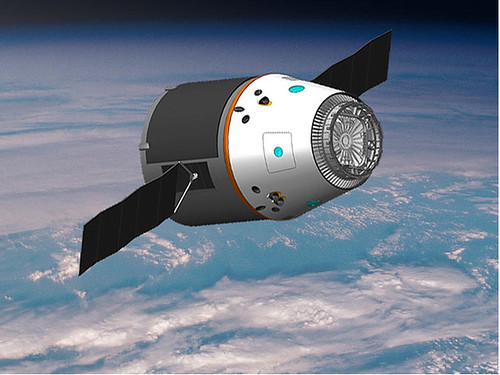House passes updated version of the bill reauthorizing the satellite compulsory license for carriage of distant network affiliate TV station signals.
[TWICE – 12/04/2009]
Congressional testimony form Government Accountability Office director Gerald Dillingham blames lack of a comprehensive U.S. national space launch strategy and unified oversight council for obstructing the domestic commercial launch industry’s ability to grow and compete.
[Satellite Today – 12/04/2009]
SatMAX gains acceptance into corporate arena within its first year in the satellite ground equipment industry, providing Iridium satellite communications repeater systems to Fortune 500 companies like ITT corporation.
[CNN Money – 12/04/2009]
TeleCommunications Systems Inc. agrees to acquire Networks In Motion, Inc., a privately held provider of wireless navigation solution for GPS-enabled mobile phones.
[SatNews – 12/04/2009]
Thales Alenia Space completes platform integration testing on the European Space Agency’s Galileo satellites.
[Satellite Today – 12/04/2009]
Sea Launch receives final approval on motion to secure debtor-in-possession financing from Space Launch Services and outlines reorganization plan.
[Satellite Today – 12/04/2009]
Austrian public broadcaster ORF purchases HD capacity from SES Astra.
[Satellite Today – 12/04/2009]
Comcast agreement to acquire majority stake in NBC Universal from GE fundamentally changes how it works with rival telecommunications and satellite TV providers, raising concern that rising programming fees may accelerate further under Comcast.
[Wall Street Journal – 12/03/2009]
Air Force’s Delta 4 Wideband Global SATCOM 3 launch from Cape Canaveral is targeted for December 5, after delay due to a ground system glitch.
[Spaceflight Now – 12/03/2009]
Arianespace prepares for final Ariane 5 launch of 2009, which will carry France’s Helios 2B military observation satellite into orbit next week.
[Space Travel – 12/03/2009]
Comtech wins $1.6m order for high-power amplifiers for Ku band satellite terminals, underscoring increasing military demand for Ku-band flyaway terminals.
[CNN Money 12/03/2009]

SpaceX conducts its first Dragon spacecraft operations training for NASA astronauts and personnel, focusing on how the crew will interface with Dragon while approaching and docking with the International Space Station.
[SatNews – 12/03/2009]
NASA’s Wide-field Infrared Survey Explorer ready for launch December 9 from Vandenberg AFB.
[Space Travel – 12/03/2009]
Globecomm Systems Inc. introduces operational commercial X band service offering to U.S. Military and Coalition Forces operating in Southwest Asia, the Middle East, and Africa.
[SatNews – 12/03/2009]
TacSat-4 satellite construction completed; ready for launch which was moved to August 2010 because of changing DoD mission priorities.
[Space War – 12/03/2009]
Northrop Grumman is awarded $500K contract to help U.S. Air Force Research Laboratory design a spacecraft "bus" with plug-and-play capability to reduce cost and schedule in developing future space systems.
[SatNews – 12/03/2009]
USAF and Lockheed Martin announce successful completion of thermal vacuum testing of the first Space Based Infrared System geosynchronous satellite.
[Space War – 12/03/2009]
SkyWave Mobile Communications makes available GLONASS navigation capability in its DMR-800L satellite data communication terminal.
[SatNews – 12/03/2009]
As the United Arab Emirates pushes into new era of space development, highlighted by recent launch of Dubai-Sat 1 and YAHSAT’s capability of buying and servicing satellites, young Arabs can be the next generation of space engineers.
[Space Mart – 12/03/2009]
SES, Intelsat, and Inmarsat establish Space Data Association in the Isle of Man, dedicated to sharing critical operational data in support of satellite operations, improving flight safety, and preserving the space environment.
[Satellite Today – 12/02/2009]

New Zealand rocket Atea-1, after landing in ocean, loses connection with its tracking satellite when GPS battery dies, stymieing recovery efforts.
[SatNews – 12/02/2009]
NASA spends $570m of the $1b stimulus money authorized by Congress on the embattled Constellation Moon program.
[Space News – 12/02/2009]
Boeing ships High-Def broadcasting satellite DIRECTV 12 to Baikonur Cosmodrome launch facility in Kazakhstan.
[Space Travel – 12/02/2009]
Hughes Network Systems ships over 2.1 million VSAT satellite terminals as of Q3 2009.
[SatNews – 12/02/2009]
The World Teleport Association launches a new "Green Teleport" campaign to help its members improve energy efficiency, slash energy costs, and make their energy-dependent businesses more sustainable.
[SatNews – 12/02/2009]
Iridium announces that ITT has received a contract from U.S. Naval Surface Warfare Center to supply 1,450 Iridium-based handheld tactical satellite communication devices for use by U.S. forces in Iraq and Afghanistan.
[SatNews – 12/02/2009]
NOAA deactivates the GOES-10 satellite after 12 years of service.
[SatNews – 12/02/2009]
Lockheed Martin gets $57.3m sole-source contract to provide operations and sustainment support for Milstar and Defense Satellite Communications System for next5 8 months.
[Defense Industry Daily – 12/01/2009]
Intelsat 15 satellite is launched from Kazakhstan by Russia following 24 hour delay for unspecified technical reasons.
[Space Daily – 12/01/2009]
Spot LLC, wholly-owned subsidiary of Globalstar Inc., announces availability of SPOT Assist Maritime, a boat towing service summoned via satellite using hand-held SPOT Satellite Messenger device.
[CNN Money – 12/01/2009]
India’s ISRO space agency has eight foreign satellites in its pipeline for launch over the next two-three years, and is looking for foreign satellites to purchase.
[Space Travel – 12/01/2009]
GOES-14 geostationary environmental satellite is placed in on-orbit storage awaiting call to duty, with tests showing all systems functioning well.
[Space Mart – 12/01/2009]
NASA says a piece of space debris being tracked will not threaten the International Space Station.
[CNN – 12/01/2009]
Iran continues to insist it will launch a new communications satellite on its own after Italy and Russia refused to launch what Israel claims is a surveillance craft designed to spy on the Jewish state and target ballistic missiles.
[Space Daily – 12/01/2009]
SPOT expands satellite messenger service coverage in Africa with new operating gateway in Nigeria.
[CNN Money – 11/30/2009]
WBMSAT PS – Satellite Communications Consulting Services







